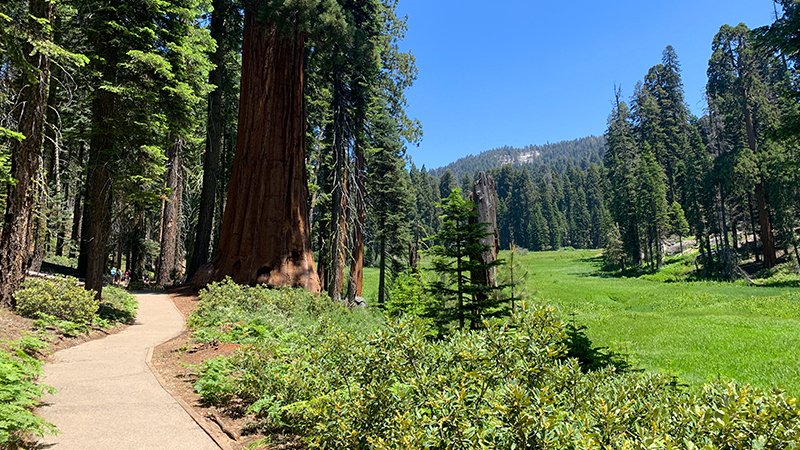
In Sequoia National Park’s Giant Forest sequoia grove, you’ll find the Giant Forest Museum, the Big Trees Trail, General Sherman Trail, and Beetle Rock Trail, the Moro Rock Summit Staircase, the Drive Through Tunnel Log, Crystal Cave, Crescent Meadow, and Tharp’s Log. It is packed with awe-inspiring views, towering sequoia trees, and lush fern covered forests. It is also the most popular and most crowded spot in the entire park!
On many weekends and throughout the summer months, Crescent Meadow Road through Giant Forest is closed to private vehicles and only open to free park shuttles. So to see many of the sights, we had to hop on the shuttle and it really wasn’t that big of a deal. After hopping off and on at Moro Rock and Tunnel Log, we hopped off at Crescent Meadow ready for one of the longer walks/hikes we did.
Crescent Meadow is a High-Sierra meadow lined with towering sequoias and dotted with a few dozen fallen trunks. Known for it’s summer bloom of wildflowers, Crescent Meadow was called “the gem of the Sierra Nevada” by John Muir.
The Crescent Meadow Loop Trail is a 1.8 mile trail that starts at the south end of the parking lot and circles Crescent Meadow. The mostly flat, paved, easy trail is perfect for families as it passes a giant tree you can climb inside and Tharp’s Log, a fallen tree that was made into a summer home.
We enjoyed the peaceful, easy walk along this trail and the beautiful meadow. We explored a side spur trail to toward Chimney Tree, checked out neighboring Log Meadow, and went inside Tharp’s Log!
Tharp’s Log
Hale Tharp, first brought to the meadow by Yukut guides in 1858, is believed to be the first Non-Native American to enter the Giant Forest. By 1861, he had built a home inside a fallen Sequoia — fifty-five feet of the log’s seventy-foot length had already been hollowed by fire.
Tharp lived in the log home every summer and In 1869, he ranched his livestock in the Giant Forest meadows until 1890 when the land became a national park. His home, now called Tharp’s Log, is well preserved. A stone fireplace and chimney, door, and window exist at the wide end along with a small shake-covered cabin extension. Inside you can see his old bed, table, and bench.
Know Before You Go
- Crescent Meadow Road winds through the Giant Forest Sequoia Grove, passing the Buttress Tree, Parker Group, Moro Rock, and Tunnel Log on the way to Crescent Meadow and Tharp’s Log. The road may be closed in winter or when the free park shuttle is in operation.
- Crescent Meadow Picnic Area sits at the edge of lush Crescent Meadow. It doesn’t have water or grills but it does have picnic tables and restrooms.
- Tharp’s Log is a hollowed giant sequoia log at Log Meadow in the Giant Forest grove of Sequoia National Park that was used as a summer shelter. It was added to the National Register of Historic Places in 1977.
- Sequoia National Park and Kings Canyon National Park are basically treated as the same park — even the National Park Service combined both parks into one website.
- The parks are open 24 hours a day, 365 days a year. Occasionally, winter storms will close roads leading into the parks until they can be plowed.
- Admission fees are good for seven days and both parks. They are $35.00/vehicle, $30.00/motorcycle, $20.00/individual entry on foot or bicycle, $15.00/person for a non-commercial group.
- There are five free admission days: the birthday of Martin Luther King, Jr., the first day of National Park Week, the National Park Service Birthday, National Public Lands Day, and Veterans Day.
- Weather varies a lot by season and elevation, which ranges from 1,370 feet to 14,494 feet. Bring layers and be prepared!
- Cell service is not available in most areas. You may get service in Grant Grove and at the Foothills Visitor Center. WiFi is available at the Foothills Visitor Center, the Grant Grove Visitor Center, and in the lobby of Wuksachi Lodge.
- Pets are not permitted on any trails at Sequoia and Kings Canyon National Parks. In campgrounds and picnic areas, pets must be kept on a leash of no more than six feet at all times.









